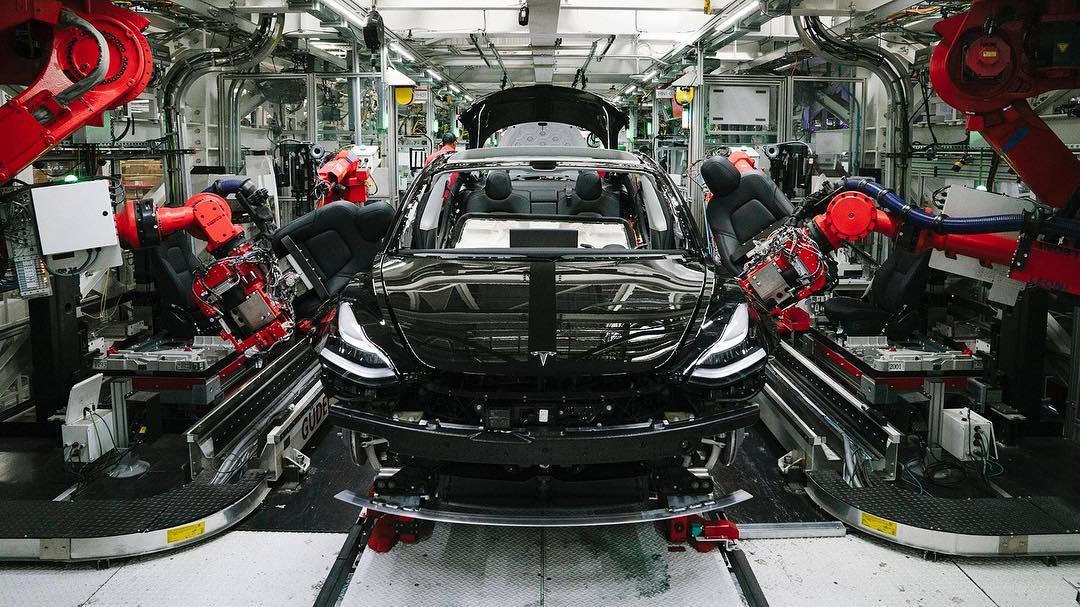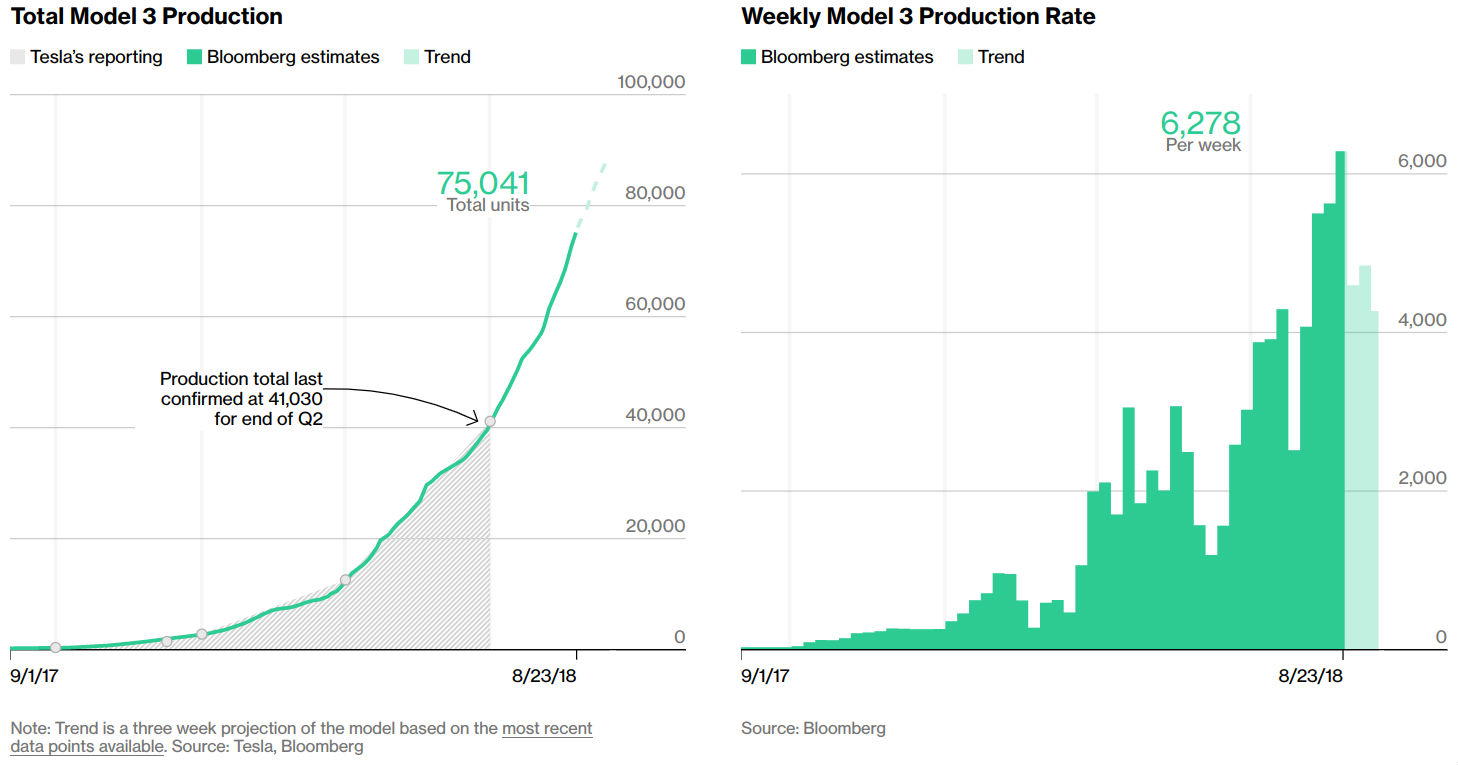

Investor's Corner
Tesla Model 3 production appears to have surpassed the 6k/week mark
Less than a week after crossing the 100,000-vehicle mark in new Model 3 VIN registrations, Tesla has seemingly achieved yet another milestone in its efforts to ramp the production of the electric sedan. After more than a year filled with bottlenecks, missed deadlines, and intense “burst production” weeks, Tesla appears to have achieved a production rate of more than 6,000 vehicles per week.
The updated estimates for Tesla’s Model 3 production are reflected in Bloomberg‘s online tracker, which uses data from official US government resources, social media reports, and direct communication from Tesla owners themselves. The publication’s tracker has gotten more accurate over the past few months, to the point where its Q2 estimates were only off by around 2% from Tesla’s actual figures.
Bloomberg‘s tracker has been showing a steady upward trend in terms of the Model 3’s production since August started. When Tesla registered its 100,000th VIN for the Model 3, the publication’s tracker estimated the company’s weekly production rate for the electric car to be at around 5,800 per week. These figures were updated today, with the production tracker now showing an estimated weekly production rate of 6,278 Model 3 per week.

Tesla’s seemingly improving Model 3 ramp was the product of a long year filled with trials and tribulations for the company and its CEO. Elon Musk recently noted in an interview that the past 12 months, much of which was spent ramping the production of the Model 3, had been one of the most difficult and painful years of his career. Nevertheless, Tesla’s production ramp for the Model 3 appears to have reached a breakthrough sometime in July, following the “burst production week” implemented in the final week of June that enabled the company to produce 5,000 Model 3 per week for the first time.
During the first weeks of Q3, Tesla exhibited signs that the Model 3’s production was moving at a healthy pace. More than 19,000 new VINs were registered during the first half of July, vehicle delivery systems were optimized, and hiring was also ramped. Musk mentioned the vehicle’s improving production figures during the Q2 2018 earnings call as well, when he stated that Tesla was able to sustain a weekly production rate of 5,000 Model 3 during “multiple weeks” in July.
It should be noted that while manufacturing 6,000 Model 3 per week is a notable feat for Tesla, the vehicle’s production ramp is only a bit more than halfway done. Tesla intends to produce as many as 10,000 Model 3 per week sometime next year, which would enable the company to saturate both the United States and other territories with the electric car. Despite being only halfway complete, the production ramp of the Model 3 is already starting to be felt by the US auto industry. In July alone, the Model 3 was able to outsell the Chevy Bolt EV — arguably its most formidable competitor today — 12:1. The Model 3 was also listed at No. 7 in GoodCarBadCar‘s list of America’s Top 20 Best Selling Cars, which included gas-powered vehicles like the Toyota Camry and the Honda Civic.

Investor's Corner
Tesla stock closes at all-time high on heels of Robotaxi progress

Tesla stock (NASDAQ: TSLA) closed at an all-time high on Tuesday, jumping over 3 percent during the day and finishing at $489.88.
The price beats the previous record close, which was $479.86.
Shares have had a crazy year, dipping more than 40 percent from the start of the year. The stock then started to recover once again around late April, when its price started to climb back up from the low $200 level.
This week, Tesla started to climb toward its highest levels ever, as it was revealed on Sunday that the company was testing driverless Robotaxis in Austin. The spike in value pushed the company’s valuation to $1.63 trillion.
Tesla Robotaxi goes driverless as Musk confirms Safety Monitor removal testing
It is the seventh-most valuable company on the market currently, trailing Nvidia, Apple, Alphabet (Google), Microsoft, Amazon, and Meta.
Shares closed up $14.57 today, up over 3 percent.
The stock has gone through a lot this year, as previously mentioned. Shares tumbled in Q1 due to CEO Elon Musk’s involvement with the Department of Government Efficiency (DOGE), which pulled his attention away from his companies and left a major overhang on their valuations.
However, things started to rebound halfway through the year, and as the government started to phase out the $7,500 tax credit, demand spiked as consumers tried to take advantage of it.
Q3 deliveries were the highest in company history, and Tesla responded to the loss of the tax credit with the launch of the Model 3 and Model Y Standard.
Additionally, analysts have announced high expectations this week for the company on Wall Street as Robotaxi continues to be the focus. With autonomy within Tesla’s sights, things are moving in the direction of Robotaxi being a major catalyst for growth on the Street in the coming year.
Elon Musk
Tesla needs to come through on this one Robotaxi metric, analyst says
“We think the key focus from here will be how fast Tesla can scale driverless operations (including if Tesla’s approach to software/hardware allows it to scale significantly faster than competitors, as the company has argued), and on profitability.”

Tesla needs to come through on this one Robotaxi metric, Mark Delaney of Goldman Sachs says.
Tesla is in the process of rolling out its Robotaxi platform to areas outside of Austin and the California Bay Area. It has plans to launch in five additional cities, including Houston, Dallas, Miami, Las Vegas, and Phoenix.
However, the company’s expansion is not what the focus needs to be, according to Delaney. It’s the speed of deployment.
The analyst said:
“We think the key focus from here will be how fast Tesla can scale driverless operations (including if Tesla’s approach to software/hardware allows it to scale significantly faster than competitors, as the company has argued), and on profitability.”
Profitability will come as the Robotaxi fleet expands. Making that money will be dependent on when Tesla can initiate rides in more areas, giving more customers access to the program.
There are some additional things that the company needs to make happen ahead of the major Robotaxi expansion, one of those things is launching driverless rides in Austin, the first city in which it launched the program.
This week, Tesla started testing driverless Robotaxi rides in Austin, as two different Model Y units were spotted with no occupants, a huge step in the company’s plans for the ride-sharing platform.
Tesla Robotaxi goes driverless as Musk confirms Safety Monitor removal testing
CEO Elon Musk has been hoping to remove Safety Monitors from Robotaxis in Austin for several months, first mentioning the plan to have them out by the end of 2025 in September. He confirmed on Sunday that Tesla had officially removed vehicle occupants and started testing truly unsupervised rides.
Although Safety Monitors in Austin have been sitting in the passenger’s seat, they have still had the ability to override things in case of an emergency. After all, the ultimate goal was safety and avoiding any accidents or injuries.
Goldman Sachs reiterated its ‘Neutral’ rating and its $400 price target. Delaney said, “Tesla is making progress with its autonomous technology,” and recent developments make it evident that this is true.
Investor's Corner
Tesla gets bold Robotaxi prediction from Wall Street firm
Last week, Andrew Percoco took over Tesla analysis for Morgan Stanley from Adam Jonas, who covered the stock for years. Percoco seems to be less optimistic and bullish on Tesla shares, while still being fair and balanced in his analysis.

Tesla (NASDAQ: TSLA) received a bold Robotaxi prediction from Morgan Stanley, which anticipates a dramatic increase in the size of the company’s autonomous ride-hailing suite in the coming years.
Last week, Andrew Percoco took over Tesla analysis for Morgan Stanley from Adam Jonas, who covered the stock for years. Percoco seems to be less optimistic and bullish on Tesla shares, while still being fair and balanced in his analysis.
Percoco dug into the Robotaxi fleet and its expansion in the coming years in his latest note, released on Tuesday. The firm expects Tesla to increase the Robotaxi fleet size to 1,000 vehicles in 2026. However, that’s small-scale compared to what they expect from Tesla in a decade.
Tesla expands Robotaxi app access once again, this time on a global scale
By 2035, Morgan Stanley believes there will be one million Robotaxis on the road across multiple cities, a major jump and a considerable fleet size. We assume this means the fleet of vehicles Tesla will operate internally, and not including passenger-owned vehicles that could be added through software updates.
He also listed three specific catalysts that investors should pay attention to, as these will represent the company being on track to achieve its Robotaxi dreams:
- Opening Robotaxi to the public without a Safety Monitor. Timing is unclear, but it appears that Tesla is getting closer by the day.
- Improvement in safety metrics without the Safety Monitor. Tesla’s ability to improve its safety metrics as it scales miles driven without the Safety Monitor is imperative as it looks to scale in new states and cities in 2026.
- Cybercab start of production, targeted for April 2026. Tesla’s Cybercab is a purpose-built vehicle (no steering wheel or pedals, only two seats) that is expected to be produced through its state-of-the-art unboxed manufacturing process, offering further cost reductions and thus accelerating adoption over time.
Robotaxi stands to be one of Tesla’s most significant revenue contributors, especially as the company plans to continue expanding its ride-hailing service across the world in the coming years.
Its current deployment strategy is controlled and conservative to avoid any drastic and potentially program-ruining incidents.
So far, the program, which is active in Austin and the California Bay Area, has been widely successful.








